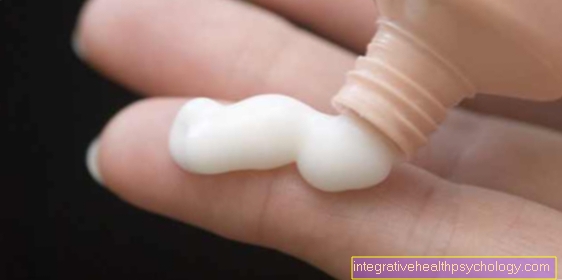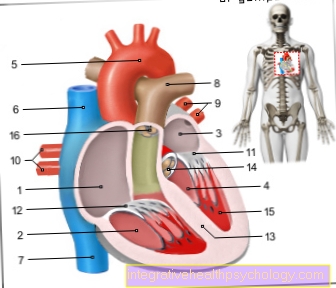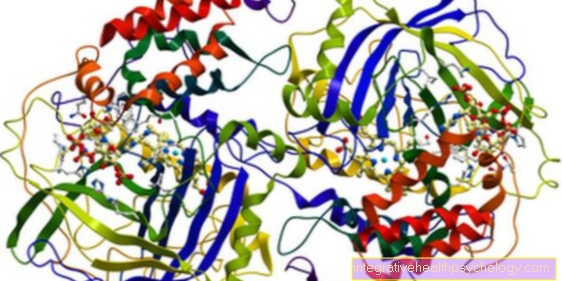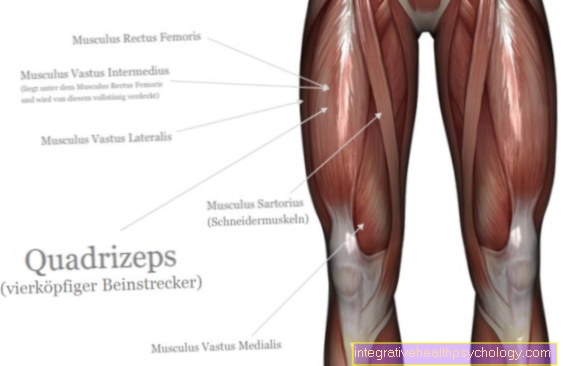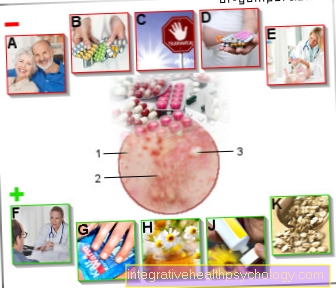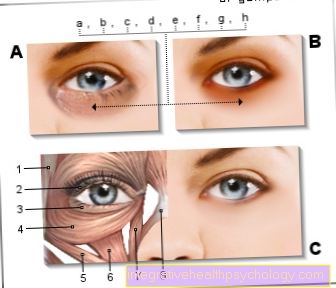Pigment disorders
Synonyms
Hyper- / hypo- / depigmentation, white spot disease, vitiligo
English: pigment disorder
definition
The term pigment disorder encompasses many diseases that lead to a change in the complexion of the skin due to the impaired formation of the color pigments in the skin. The usual pigmentation comes from certain cells of the epidermis (epidermis), which are called melanocytes.

These form the brownish-black color pigment melanin, for which they are stimulated by sunlight. This pigment is intended to prevent UV light from penetrating the deeper layers of the skin and thus protects the skin. One speaks of a pigment disorder if this synthesis does not take place in an appropriate manner for whatever reason and local or large-scale color changes occur. A distinction is made between two different forms of pigment disorder.
- On the one hand there is hyperpigmentation, in which there is an excess of melanin (Hypermelanosis) and on the other
- hypopigmentation, which is a lack of melanin (Hypomelanosis) and of which there is still the special form of depigmentation, in which melanin is completely absent.
The most important pigment disorders associated with hyperpigmentation are freckles, age spots and melasma; hypopigmentation occurs in the clinical pictures of albinism and vitiligo. As can be seen from the examples above, not all pigment disorders have a real disease value.
Epidemiology
The different forms of Pigment disorders occur with different frequency and in different groups of people. So are Freckles For example, more likely in younger people, but age spots are only found in people over 40 years of age. Melasma is found more and more in women; the other disorders do not seem to prefer a specific gender. The disease that is classically referred to as pigment disorder, namely white spot disease, occurs in around 0.5 to 2% of the world's population. In the white population there is about one person with albinism for every 20,000 inhabitants.
Pigment disorders in children
Whereas some Pigment disorders only in the course of life, for example through exposure of the skin to harmful substances UV radiation, occur are some Pigment disorders present from birth.
Most Pigment disorderswhich occur in childhood or are present from birth no disease value and do not require any therapy. Generally, when differentiating between Pigment disorder between one Hyper- and one Hypopigmentation can be distinguished.
Among the diseases of the Hyperpigmentation include for example the popularly called Moles called changes in the skin. Moles (medical: Lentigo simplex) can be present immediately after birth or occur in childhood. New liver spots can also appear later. You want an increase in Melanocytes which are responsible for the dark color of the affected area of the skin.
Same goes for Café-au-lait spotswhich can also be present at birth or only become visible in the first few months. These are noticeable if more than five areas of the skin are affected by café-au-lait spots, as this is a sign of some genetically inherited diseases can be. Up to three of these Pigment disorders can be found in 10-30% of all older children.
The so-called Pigment nevi, including the Mongolian spot heard are Pigment disorderswhich sometimes occur in newborns.
In which Mongolian spot is a harmless collection of Melanocytes - cells in the skin, which are largely responsible for pigmentation. This disappears over time Pigment change however and thus belongs to the reversible pigment disorders.
Other forms of Pigment nevi however show a certain Risk of degeneration on, which is why in these cases a lifelong control by a dermatologist is required.
Freckles (Ephelids) are Pigment deposits in the skin, which is yellowish, brownish in color from the rest of the skin. You like one Increase in melanin the number of melanocytes is normal. They usually appear from the age of three to five and usually decrease in intensity over the course of life. Freckles often correlate with red hair color and pale skin, as the gene responsible for freckles is also responsible for these characteristics.
Besides the Hyper (over) pigmentation also exist Hypo (under) pigmentationthat can be found in infancy or childhood. Genetic causes as well as acquired ones Pigment disorders can occur equally.
A Hypopigmentation usually goes with one reduced number of melanocytes or melanin and is irreversible in most cases. Examples of Hypopigmentation are Albinism, the White spot disease (Vitiligo), Waardenburg syndrome, Depigmentation nevus and some other pigment disorders.
In most cases of Pigment disorders no therapy is required in children.
Should be a cosmetic therapy treatment with Creams or one Laser treatment the skin. However, this should be discussed thoroughly with the doctor, as these treatments do have side effects that must be weighed up.
causes

The causes of pigment disorders are at least as diverse as the various clinical pictures that can trigger them and in some cases have not yet been finally clarified. In some cases, several factors have to come together to create a Change in skin to effect. The following can be responsible for a pigment disorder: hereditary factors, mechanical irritation (such as pressure or friction), thermal stress (heat or cold), certain Medication, Cosmetics or hormonal changes, such as changes in the hormonal balance due to taking the Birth control pills (see: Pigment disorder caused by the pill) or during the pregnancy.
A Pigment disorder in the form of Hyperpigmentation can arise either from the fact that more melanin is formed or from the fact that the melanin is accumulated in the skin, both of which cause it to look darker in the affected areas. There are some triggers that can stimulate melanocytes to massively produce melanin or to multiply through cell division. These include, among other things UV radiation, hormones or special types of Inflammation. For example, there is what is known as post-inflammatory (after inflammation) hyperpigmentation, which can be the result of inflammatory skin diseases and often with one psoriasis or accompanied by a rash and may be present for months after the inflammation.
The reason for hypopigmentation is that the melanin content is reduced, which can happen due to a reduced number of melanocytes or a reduced melanin production. This color pigment is completely absent during depigmentation. The cause of this can be a destruction of the melanocytes, for which, for example, extreme cold, X-rays, various toxic substances or inflammation come into question. Hypopigmentation can also be the result of an impaired transmission of melanin to the horn-forming cells of the epidermis, for example through inflammatory processes such as psoriasis or Neurodermatitis can come.
In the White spot disease (Vitiligo) the melanocytes are likely to become through an autoimmune process (i.e. through an inappropriate defense reaction of their own immune system) destroyed. Albinism is a congenital disorder in which melanocytes do not form at all.
diagnosis

The diagnosis of a pigmentation disorder can usually be made by the doctor or independently by the fact that one affected areas, since the outward appearance of pigment disorders is usually very characteristic of the individual forms. In addition, the patient's medical history is asked (anamnese), which often makes it easier to find or secure a result. For example, the Family history plays an important role in diagnosing genetic diseases such as white spot disease. If in doubt, the doctor can also take a tissue sample (biopsy) and examine it under the microscope.
treatment
In most cases, pigment disorders require no treatment, since they usually have no disease value. Nevertheless, new or changing skin changes should be examined by a dermatologist so that a possibly malignant diagnosis can be ruled out. If the skin actually deteriorates, the affected area is usually removed generously. This is done with local anesthesia and is absolutely painless.
Although a disease value for most Pigment disorders does not exist, there is a considerable level of suffering among the persons concerned. Especially at Pigmentation disorders in the face or the hands, or if a large area is affected, is one cosmetic therapy quite possible. In these cases, creams come into question, which can conceal the affected areas and thus improve the appearance of the pigment disorders. Some creams contain bleaching agents that can bleach the affected area and make it appear lighter. However, these creams can cause irregularities and should therefore be used carefully.
In particularly drastic cases, after clarification with the treating dermatologist, a Laser therapy should be considered for the treatment of the pigment disorder. Before the laser treatment of some pigment disorders, a sample must be taken from one of the affected skin areas, as the presence of a malignant skin tumor must be reliably excluded before starting therapy. If the present pigment disorder is an option for laser therapy, this therapy option is usually highly effective. The pigment deposits are destroyed by the laser beam and can then be broken down by the body's own cells.
To prophylaxis of pigment disorders, risk factors for the development of the changes should be avoided.
One of the main risk factors for the pigment disorder to occur is one Exposure to UV radiation. Especially people with fair skin type should strictly avoid exposure to UV radiation and only expose their skin to dangerous radiation with sunscreen.
In some forms of pigment disorders, lifelong checks by the treating dermatologist are required. By taking photos of the affected areas, changes in pigmentation can be identified and treated if necessary.
Creams for the treatment of pigment disorders

Most Pigment disorders require conscious use of suncream. As many of the changes in the skin with an increased exposure to UV radiation go hand in hand, with consistent use of a sun protection cream, the occurrence of many of the Pigment disorders be prevented. Even or especially if there are already pigment disorders, this is the right choice Prophylactic creams further changes advisable.
At Hypopigmentation disorders It is usually also advisable to use a sun cream, as the cosmetic effect of the pigmentation disorder is less drastic by using a cream with a sun protection factor. The Risk of sunburn the non-pigmented areas are also greatly reduced.
At a Hyperpigmentation Creams can be used which, by selecting the color shade of the cream, make the cosmetic impression of the pigment disorders appear weaker. Here, the skin tone and the color of the cream must be coordinated so that this so-called camouflage can work. The use of such creams can in many cases significantly reduce the existing level of suffering of the people concerned. Since the use of these creams usually has no or few side effects, their use can be recommended. There are also some Whitening creams on the market, which by a Skin whitening the appearance of Pigment disorders should decrease. However, the use of these creams can cause unevenly bleached skin and should therefore be used with caution.Most creams in this category also contain it Exfoliating substanceswhich is why the skin can often be irritated and reddened after using the creams.
Should the Pigment disorder through a Inflammatory process (for example Pityriasis alba), anti-inflammatory creams can be used.
Before a Self-therapy or concealment of pigment disorders is carried out with creams, a dermatologist should always look at the affected areas so that a possibly malignant diagnosis can be excluded.
forecast
The course of the different types of pigment disorders varies considerably. How they develop further depends on both their cause and their characteristics. The symptoms of the Albinism For example, it persists for a lifetime because this disease is genetically determined. Freckles, on the other hand, can come and go to a greater or lesser extent and very often they regress, at least partially, on their own in adulthood. In contrast, the white spot disease shows a progressive course: The spots become more numerous and larger and can merge into large-scale herds. In rare cases, symptoms have been reported to resolve spontaneously (Repigmentation).
Summary
At a Pigment disorder is the formation of Color pigments disturbed, which causes the skin in certain places either stronger or weaker is colored. Depending on the cause (genetically conditional or through external influences) the different types differ in their shape and characteristics.
What all pigment disorders have in common, however, is that they either have no or only a very low disease value. Patients are actually not restricted in their normal life, except for the fact that they may multiply Sun protection have to take care of or find the externally visible changes emotionally stressful. For such cases there are some remedies that can normalize the skin color again and thus alleviate the suffering of those affected.


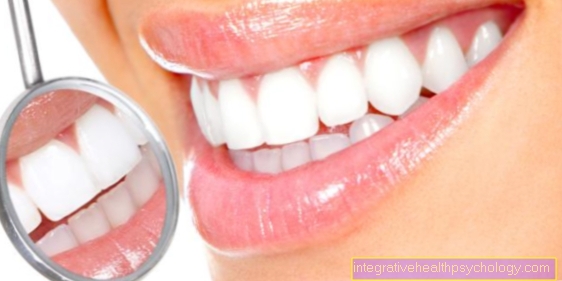



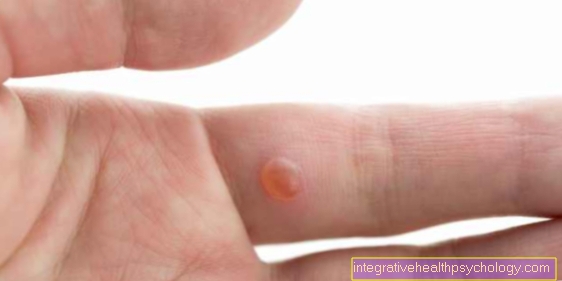
.jpg)


